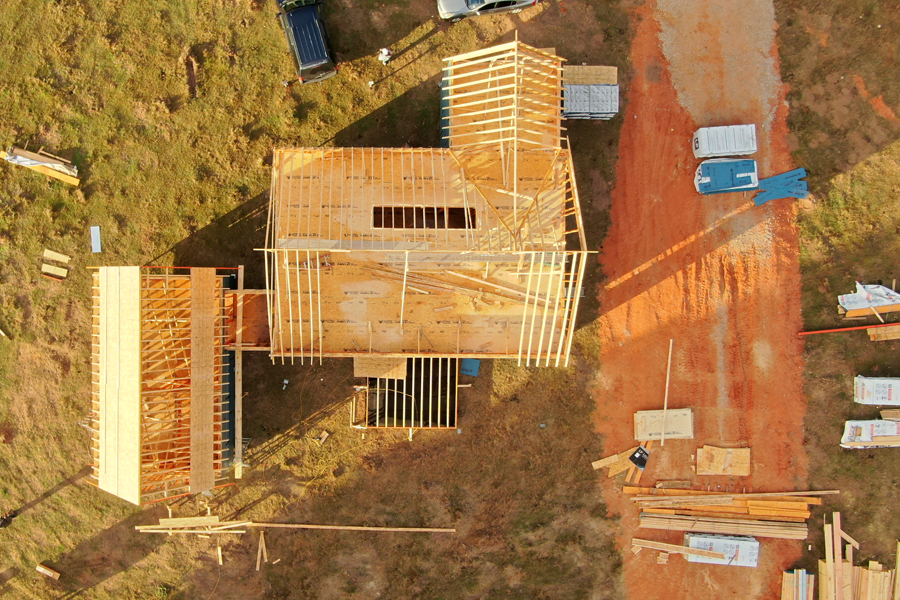News & Stories5 min
The Science Behind Carbon Storage and How It Affects Your Sustainable Builds
Building a sustainable home is a growing aspiration across the country. While net zero home construction tends to concentrate in certain regions, the need for sustainable building materials is increasing across the entire country.
As homeowners gain deeper knowledge about sustainable building you may be fielding questions about carbon storage, carbon capture methods, and how trees impact the environment.
As stewards of responsible forestry and members of SFI®, we at LP Building Solutions remain dedicated to this important topic. Before digging deeper into carbon capture building technologies, let’s take a moment and revisit the science of photosynthesis.
Trees: The Best Carbon Capture Technology
Trees are naturally one of the best types of carbon capture technology in the world. Photosynthesis is the process where trees use sunlight, water from their roots, and carbon dioxide out of the air to release oxygen. The result is glucose, which fuels the growth of trees by helping to create wood, branches and roots.
The carbon captured from the atmosphere is locked up in the trees. As trees get older, the process of storing carbon dramatically slows as they begin to break down and become more susceptible to forest insects, disease and wildfire-all of which can be sources of carbon release. Sustainable forest management practices allow us to harvest, plant and grow new forests, maintaining a continuous cycle of forest age classes across the forest landscape.
LP Building Solutions believes that sustainably managed forests make a vital contribution to
the world by providing environmental benefits indispensable to our quality of life. Our commitment to provide these benefits is reflected in our daily actions across all of our operations.
Carbon Capture Building Materials and Engineered Wood Products
Trees maintain carbon with approximately 50% stored within the dry mass of wood fiber.
When trees are harvested for building products, such as LP Structural Solutions products, they continue to store carbon long after they’re transformed into the engineered wood products used in our homes and buildings. Since carbon dioxide is stored in the products, it’s not released into our atmosphere to create additional greenhouse gasses.

Carbon Capture Technology With Carbon Capture Building Materials
LP is committed to producing sustainable products from renewable resources with leading carbon storage attributes. Our products are engineered to help withstand exposure to the elements and the passage of time and to reduce the amount of environmental waste at construction sites.
While trees are the best carbon capture method, they are also renewable resources. In fact, LP replants about four million trees in the Canadian forests the company manages. Manufacturing responsibly sourced, high-performing and longer-lasting engineered wood building products is fundamental to our sustainability commitment.
LP's siding manufacturing facilities use a deciduous, hardwood tree called trembling aspen to produce siding products. Aspen trees form new tree trunks from their root systems after tree stems have been harvested. They grow quickly but have a shorter lifespan due to their susceptibility to insects and disease generally after 50+ years of age. OSB mills use southern yellow pine as well as aspen.
Sustainable forest management operations in mature aspen forests help to restore these aging ecosystems. In turn, healthy aspen forests provide habitats for plant and animal species as the new trees grow through their various stages of development.
Doing the Right Thing to Build a Bright Future
LP Building Solutions has a mission of Building a Better World™ that is inextricably linked to protecting the environment, minimizing waste, and supporting its communities for future generations. We seek to continuously improve to strengthen our tomorrow.
It also means that LP never stops thinking about its progress and is never satisfied with “good enough” as it works to build a brighter future.
Want more sustainable building material ideas? Discover how insulated sheathing contributes to better energy efficiency.
Continue Reading
Resiliency Solutions
5 minIntroducing LP® SmartSide® ExpertFinish® Naturals Collection™: Nature-Inspired Beauty Meets Engineered Performance
We’re excited to introduce the LP® SmartSide® ExpertFinish® Naturals Collection™, a bold new addition to our trusted line of engineered wood siding and trim that delivers the warmth and beauty of nature with the advanced protection and performance builders and homeowners expect.
Labor Solutions
5 minChoosing the Right LP® Structural Solutions Product for Your Build
When it comes to building strong, reliable, and high-performing structures, the materials you choose matter. At LP Building Solutions, we understand that every project, whether it's a single-family home or a multifamily development, requires structural components that meet your needs for strength, durability, and efficiency.
Sustainability Solutions
5 minBuilding a More Sustainable Future with LP Building Solutions
In today's world, sustainability is no longer just a buzzword, it's a blueprint for responsible living and smarter building. As the construction industry seeks ways to reduce its environmental footprint, LP Building Solutions is focused on providing innovative building materials for eco-conscious builders to help reshape what it means to build sustainably
News & Stories3 min
History of Partnership with Gary Sinise Foundation
The LP Foundation is a proud partner of the Gary Sinise Foundation, which supports wounded veterans in several ways. You can learn more about the LP Foundation here.